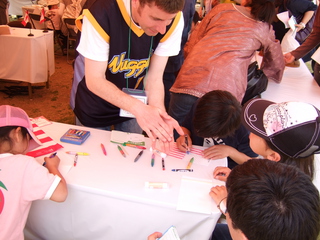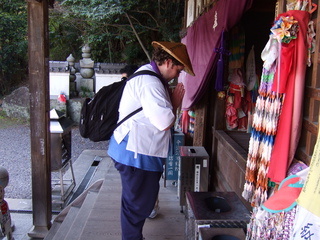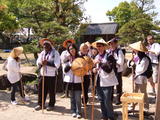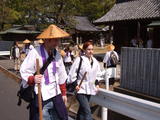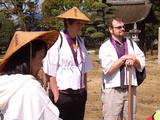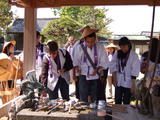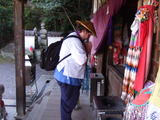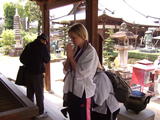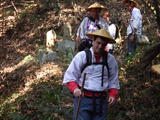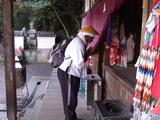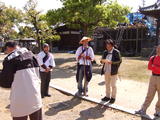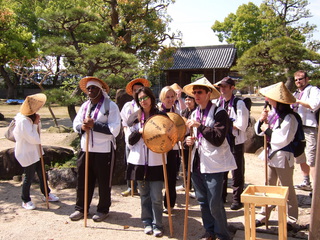 Henro Experience Reflection
Henro Experience Reflection
I was grateful to have another chance to do a walking henro experience. I enjoyed talking with everyone in our henro group as we walked. The weather was perfect. I was grateful because Japan is often either extremely cold and dry or hot and humid with little mild weather in-between. It had also rained almost the entire week before, which I have been told is unusual for Kagawa this time of year.
Mitoyo City is beautiful. But it is far from Takamatsu, so it's not a place people often have a chance to visit. Because we were on a tight schedule, I felt like I was rushing more than I have in the past. I wanted to have more time to take in the scenery. I hope I can visit the area again someday.
I often visit some of the 88 temples when I have free time. Some are very impressive, and others are quite modest. The first temple we visited, Motoyamaji (Temple 70) was pretty and newly renovated. The people working there were very friendly to foreign visitors.
However, I thought Iyadanji (Temple 71) was much more impressive. It is carved into a mountain, and is one of those temples with grounds that just keep on going and going. It is no wonder people from hundreds of years ago chose a place like that to build a temple. The peacefulness of the surrounding forest and high elevation reminded me a bit of Mt. Koya. I appreciated the lecture from the monk, because I have only had two other chances to hear lectures from monks at Shingon Temples. But his soothing voice, the incense, and the peaceful atmosphere of the temple combined with exhaustion from the trek made me very sleepy. The buddhas carved into the mountain and view from the top of the mountain were impressive.
Because of heavy rains the day before the leaf-covered ground was soft and slippery, the walk down the mountain was extremely dangerous. Fallen trees blocked the path, areas of the path were less than a foot wide along a steep drop. There were times when the path merged with the stream we had been walking along.
I wasn't sure if the path had actually gone into the stream until another hiker pointed out the "へんろ道" sign hanging from trees above it. The slippery mud combined with walking through the stream soaked through my shoes into my socks and made it difficult to get secure footing. At least one member of our group slipped on the way down and hurt his back. It was fun and challenging, but I was also very nervous. I felt accomplished (and relieved!) when we finally emerged from the woods at the bottom of the opposite side of the mountain.
When a sign-up deadline was set so that insurance could be arranged for henro experience participants, I thought it was a little excessive. But on the way down the mountain from Iyadanji to Kaiganji, I finally understood why insurance was necessary. I learned soon after the experience that the reason why henros where white is because if they die along the way, they are ready for their memorial service. In Japan, the deceased are dressed in white. Although I am sure the rate of death while doing henro is far lower than it was in the past, after my third walking henro experience I certainly appreciate just how challenging the walking pilgrimage is, and admire the people who complete it from beginning to end.
I am sincerely grateful to all the people at the International Affairs Department at the Kagawa Prefectural Office as well as the people working at the temples who made it possible for us to have this experience.
Barbara Barrett
2010 Archive
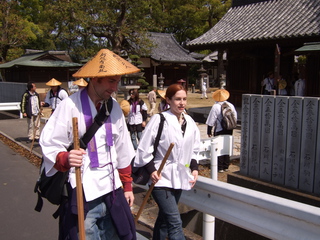 The 88 Temple pilgrimage of Kobo Daishi is more than a tourist trap. It's one of the bits of Shikoku culture that residents soon find themselves as familiar with as udon or iyokan. Entire seasons seem incomplete without the tinkling of bells dangling from walking sticks and the sound of distant chanting. Just the sillouette of a white-garbed traveller in a wide sedge hat can inspire a twinge of respect or even charity. The spare coins in our wallets suddenly seem heavier at the sight of a pilgrim's begging bowl.
The 88 Temple pilgrimage of Kobo Daishi is more than a tourist trap. It's one of the bits of Shikoku culture that residents soon find themselves as familiar with as udon or iyokan. Entire seasons seem incomplete without the tinkling of bells dangling from walking sticks and the sound of distant chanting. Just the sillouette of a white-garbed traveller in a wide sedge hat can inspire a twinge of respect or even charity. The spare coins in our wallets suddenly seem heavier at the sight of a pilgrim's begging bowl.
As much a part of the fabric of my daily life the pilgrims have become, I had never walked in their shoes. I suppose I'd never even thought of it. To most people, walking the countryside to visit temples seems an antiquated form of torture. After all, we have trains and busses for that! But thanks to the efforts of several international exchange groups active in Kagawa Prefecture and the assistance of learned local guides, I was given a chance to walk part of the circuit as it was meant to be walked and get a glimpse of some of the more charming, hidden-away parts of the 88 Temple route.
We travelled from Motoyama Temple to Kaigan Temple on foot, in the company of friends old and new. At each temple we were met with friendly faces and helpful explanations. The historic buildings and sprawling grounds were made all the more intriguing with a context in which to place their architecture, statuary and incence-scented interiors. There is a wealth of history waiting to be uncovered by curious visitors.
The paths between the temples run through some of the most gorgeous, authentic countryside Kagawa has to offer. The road winds through rice paddies, mountains, lakes, streams, reservoirs, orchards, shrines and neighborhoods large and small... ocaisionally dissappearing altogether for a stretch of forest or a major highway. In each place we found all manner of wildlife. We saw ducks, turtles, hawks, lizards and songbirds at nearly every turn ~ some species unfamiliar to me. It's possible that some of them don't live in my home country, but it seems even more likely that I'd simply never paused along a forest-path long enough to appreciate them as they quietly went about their business overhead and underfoot.
The pilgrim trails twist through mountain and forest alike. Fallen trees bisect the path and streams carry it away here and there, leaving no doubt as to the extreme age of the half-buried stones underfoot. I found myself greatful for the company of a multitude of surprisingly well-tended statues the guardian boddhisattva Jizo dotting the path. Some were deliberately cleaned and cared for, decorated with cut flowers and small offerings. Others were being tended by nature itself, surrounded by more erratic sprays of wildflowers with offerings of acorn shells and fallen leaves. These statues and their remarkable variety of serene expressions are the surest way to be sure that you're still safe on the path to the next destination.
They say that when you walk the 88 Temple Pilgrimage, you walk with the Buddhist master who originated it: Kobo Daishi. Walking with purpose and contemplation, some may gain new perspective on our lives and the buddhist concerns of earthly suffering. But one need not have such lofty goals to enjoy the beauty to be had along the way. Walking the 88 isn't just "walking with Kobo Daishi", it's walking with Kagawa itself.
Jessica Nettles
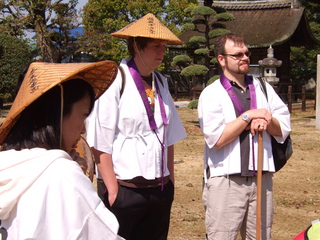 Henro is for Lovers
Henro is for Lovers
When we began last week's tour of Motoyama and Iyadani temples, I was excited to continue with the henro journey I began about a year ago. I was picking away at the 88 temples one by one and collecting those precious stamps in my henro book, so I jumped at the chance to check off a couple more before leaving Japan in July. It was much to my dismay then, when upon arriving at the first temple, things looked a little too familiar. As it turned out, I had already been to Motoyama before.
This did nothing for my attitude, especially considering it was the beginning of a long day that would be spent retracing a familiar 18km hike. I was convinced I was about to waste my Saturday, one I could have spent half-naked on my couch, surrounded by food scraps and watching TV. Instead, as often happens on any stretch of the henro journey, I found myself having a great time walking the trail with my close friends.
From the start, it seems that the entire henro experience has been pegged as more of a personal journey. This is surely derived from its roots in Buddhism, but is also easy to see in the simple physical aspect of the hike. Walking about 1500km in just over a month is no small feat, and one that is appealing as personal test of will and strength. In my experience, however, the henro path seems better suited as a means to strengthen relationships, whether they are with close friends or those other pilgrims one meets along the way.
Now, when I flip back through my stamp book to reminisce on my henro journey thus far, I notice that my fondest memories are derived from the conversations I had with my friends or the little side adventures I had meeting new people. That's not to say that the history and nature I've encountered along the trail weren't incredible. On this last organized hike, for example, Iyadani temple, built into a cave and perched at the top of a small mountain stands out in my mind. But I will especially remember the jokes made, the deep philosophical conversations, and the life stories told along the way, and it is for these reasons that my seemingly awful start to a day blossomed into a fond memory by the end of our hike.
I would suggest, then, that those interested in beginning their own henro journey find a friend or two to join them, or at the very least, try to get to know as many of their fellow pilgrims they meet along the way. At the risk of sounding clichéd, there really is something magical that happens when a long hike and companionship meet; and, rest assured, the henro trail is one hell-of-a-long hike.
Reese Mankenberg
 Motoyamaji to Iyadaniji
Motoyamaji to Iyadaniji
It was beautiful day and the best weather for a gentle trek. Cool breezes reminding one of the winter just ended and the bright sunshine of the long hot summer ahead this day would be exceedingly pleasant.
The first temple, Motoyamaji, was a small oasis of serenity in the semi urban mix of rice fields and compact housing. The effect of the temple seems spread to the nearby streets as the narrow laneways that lead to the temple precinct are lined with old houses of wood and tile. The walk from there north toward next temple, Iyadaniji, was long one through many different areas of coastal Kagawa. It crossed major and minor roads, passing through built areas and onto expanses of rice fields and over several water courses. But the real treat is when the going gets a little tougher. The last few kilometres before Iyadaniji start to climb through beautiful hillside woods. Stopping at a "michi no eki" or road station for lunch, some of the more adventurous participants joined kids playing on an extensive and somewhat grim super jungle gym left over from an era with much larger public works budgets. After refreshments the path up the final few kilometres to the temple are short slog with some very attractive artifacts such as a 15th Century bronze statue of Kanon. A set of stairs with 108 steps which with the exertion of effort for each step, one sin is absolved and the pilgrim becomes that much purer at the top. The temple area itself is both beautiful and fascinating. We were extremely lucky to be given a short talk by the head priest and heard of the traditions of commemorating lost loved ones and of the temples origins and the excavation of the Lions Mouth Cave which contains ancient figures representing Kobodaishi and his parents. All this topped of with outstanding views over the mountains to the south before heading north again down a real forest trail before emerging in to modern Kagawa and the last few kilometres to Kaiganji station. With a mix of both rural mountain this trek was easy and rewarding and the temples, as ever, wondrous.
Richard Talbot
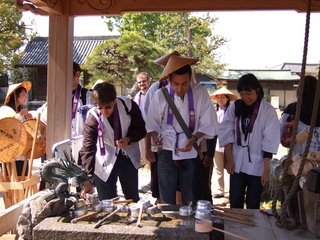 So, if you have lived on Shikoku for as long as I have, you have often seen people trundling along with a wide-brimmed straw hat, walking stick, a backpack, and usually a pair of decent looking walking shoes. Whenever I saw them, the same questions rattled around in my head:
So, if you have lived on Shikoku for as long as I have, you have often seen people trundling along with a wide-brimmed straw hat, walking stick, a backpack, and usually a pair of decent looking walking shoes. Whenever I saw them, the same questions rattled around in my head:
• Why are you trundling?
• No..really....why are you doing that? Is this to get in shape?
And the ever common:
• No seriously....why?
I couldn't understand it.
I had talked to people who had visited "The 88" by car. I had chatted with residents who had done them via bicycle. I had even shot the breeze with friends who had taken bus tours of it.
However, once/twice a year I would meet a human(!) who had done the entire thing by foot...while garbed in henro gear. And to be completely honest, although I was impressed by their feet (feat!), I thought that they were a few おかず short of a 定食.
Thus were the thoughts bouncing around my head when I found myself deciding it would be a good idea to spend a Saturday walking 18 kilometers to three of the eighty-eight temples. I decided it was time for me to figure out why people were doing this.
* * *
"Whoa."
The first half of the day had featured a stop at a temple I had been to years before, a walk along a road I had biked down before, and a visit to a temple I had been to one year prior.
"Wow."
Although the temple grounds of Iyadani were still as impressive as they had been before....I found myself wondering why I had bothered walking there. Surely cycling there, as I had done previously, would have been more efficient.
"This is ancient."
I was clad in the henro hat, with the henro stick, a bell to warn creatures of my presence, white clothes to..um...warn creatures of my presence, and my own pair of decent walking shoes.
"Look! You can actually SEE where the stairs used to be! This is amazing! You can tell people have been walking along here for hundreds of years."
I, yet had not started to feel, what the call the "henro-spirit" until we ventured to the walking path behind Iyadani temple.
"This is.....indescribable."
What was indescribable was a forest, covered trail we were venturing along down a mountain. Underneath our feet were the remnants of broken stairs. And I do mean remnants. If you were not paying attention, you would completely miss the fact that we were going down a trail that had at one time been completely en-staired.
However, time had passed and these stairs were now small little concrete footholds, that disappeared at the times you needed them and reappeared every now and then disguised as nearby rocks.
There was no question as to why stairs had been installed in the annals of time. The path was quite dangerous without them. The previous week had been somewhat wet, and the trail was quite muddy, slippery, and another adjective I don't even know. One false step, and you had the distinct impression that you might end up falling into the abyss of trees to never be heard from again. Just your bell-clad walking stick falling after you to let others know of your disappearance.
"whoa!"
I was unable to say much else as I journeyed down the craggy path. My attention was either drawn to the way ahead of me, or to the trees surrounding me.
Every now and then a ray of sunlight would catch a leaf in a way that didn't seem fully real. I would catch it out of the corner of my eye and quickly try to find it again.
Sometimes I would look at a tree and wonder how old it was....only to be distracted by an even older looking tree to wonder how old it was.
Often, I would find myself imagining how it felt to do the trail....this trail..in the time before cars, buses, and bicycles existed.
And as quickly as I had found myself feeling as though I was actually walking in the shoes of Kobodaishi, we were out of the forest.
We were back on pavement with a dam stretched out to the left of us.
I exhaled a carbon dioxide infused sigh and looked behind me wishing that we could return to the forest again. It had been something...from a different time. Something...extraordinary. Something that could only be described as...
as....
!!!
Nick Hawkins
I enjoy seeing the busloads of retirees disembarking in front of ancient temples, their white shirts looking fresh pressed, straw hats bobbing around as they twitter to each other. Usually when I see henro, it is these types of people, and while we foreigners waited in front of Motoyamaji for the day to start, a fresh group of retirees meandered into the temple. It is easy to forget that the Shikoku 88 temple circuit started as an ascetic practice that take many grueling months to complete. For many, it still is. When I looked past the gaggle of retirees chatting together in between chanting to Kukai, there was a somber henro whose jacket was less than white and whose entire appearance was that of a man who has spent many weeks hoofing it over these mountains with nothing but the necessities and a bowl to ask for money so he can continue on his pilgrimage.
On this last henro hike we trekked down one of the back mountain paths leading away from Iyadaniji, where you probably won't find a stray group of retirees chatting. As I carefully chose each step down the slick muddy mountainside, I thought of the somber dirty henro I saw earlier that day, and all the centuries of ascetics who spent months quietly suffering through the same areas in search of enlightenment. I had to concentrate on each step I took, lest I slip and fall down a mountain, making me block out the normal, day-to-day thoughts. That's exactly what this experience is supposed to do for a person. It's hard to worry about paying bills, or making the next lesson plan, or buying the newest manga when you are focused on where to place your foot on this precariously placed slippery rock with a five meter fall to one side. While the retirees safe in the bus traveling paved roads to other temples aren't worried about impending injury, I'm sure they are getting the same escape into a simpler life.
After completing the near twenty kilometer henro hike and feeling a sense of somber tiredness, I had to be slightly envious of that silent disheveled henro I saw earlier that morning amongst the group of retirees. His is a long and arduous journey, but I'd love to always have that free and quiet mind I had at the end of the day.
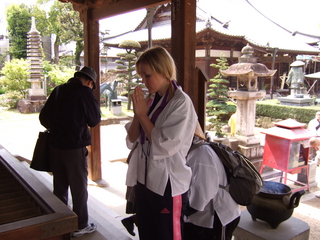 Cool, crisp morning air
Cool, crisp morning air
Sunlight kisses cheek softly
Slept-in, Panic starts!
Rush against the clock
Shower brush dress pack and leave
Ready, set, START-O
Zig-zag across town
Dodging cars and obasan
Like Family Circus
Panting, Throbbing pain
Sweat in train window reflects
ギリギリよ!
Warm faces gather
Encircle to study, learn
Question, muse, engage
Fun company kept
Conversations encourage
To push past the bend
Hills hum with silence
Midday sun casting all over
Kukai's shadow
Mountainside of death
Narrow path with no safety
Wish for insurance
Following Kukai
His road flooded by week's rain
Henromachi gone
Escape Death Mountain
Enjoy a view only seen through
Shared experience
Though it overlapped
In its talks, wear, and people
一期一会
Aandrea LaFavor
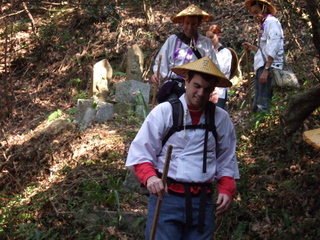 As a foreigner living in Japan, there are many opportunities to experience and share everyday occurrences with Japanese co-workers and friends. However, all of these experience happen through the perspective of exactly that--a foreigner living in Japan. But no other experience has allowed us to so profoundly step inside the life of a Japanese quite like going on a henro pilgrimage. Walking on the same streets and in the same traditional garb as thousands of Japanese pilgrims before you, it is easy to feel a special bond with the temples you visit and the people that worship in them. In a way, it makes me feel closer to Japan in general. While I may not share the hardships of the journey or the devoutness of faith as the typical Japanese pilgrim, I have a greater appreciation for the spectacular undertaking these people have chosen to take on. I felt extremely humbled as I imagined those who walk for hundreds of miles to become closer to their religion, and to better themselves in the process.
As a foreigner living in Japan, there are many opportunities to experience and share everyday occurrences with Japanese co-workers and friends. However, all of these experience happen through the perspective of exactly that--a foreigner living in Japan. But no other experience has allowed us to so profoundly step inside the life of a Japanese quite like going on a henro pilgrimage. Walking on the same streets and in the same traditional garb as thousands of Japanese pilgrims before you, it is easy to feel a special bond with the temples you visit and the people that worship in them. In a way, it makes me feel closer to Japan in general. While I may not share the hardships of the journey or the devoutness of faith as the typical Japanese pilgrim, I have a greater appreciation for the spectacular undertaking these people have chosen to take on. I felt extremely humbled as I imagined those who walk for hundreds of miles to become closer to their religion, and to better themselves in the process.
Dave Wilson
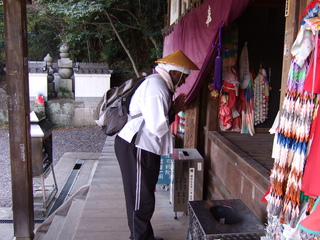 This is my second time participating in the henro pilgrimage and although the distance was longer this time (18.5 km), I found it easier and more enjoyable the second time around.
This is my second time participating in the henro pilgrimage and although the distance was longer this time (18.5 km), I found it easier and more enjoyable the second time around.
My first time we visited Yashimaji and Yakuriji in November 2009 and this year Motoyamaji and Iyadaniji. The reason I love participating in this pilgrimage is because it's a great way to learn about Buddhism for people like myself who don't necessarily spend a great deal of time studying and reading about it. I'm glad to be able to share my growing knowledge of the 88 temple circuit with visitors to Kagawa. I'm so thankful for being able to participate this time around and again, would encourage anyone visiting Kagawa or living in Shikoku to participate and share their experience with the world.
Omar Kotondi
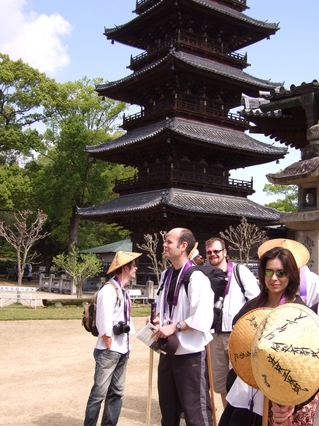 I had been very much looking forward to this ohenro walk. Hiking and religions are both life long interests to me, and ohenro is an excellent combination. I ask most people that I meet whether they are interested in ohenro in the hope that one day I will meet someone that hares some of my interests. I have visited about a quarter of the 88 temples so far, and walked between a few, but had not visited Motoyamaji, Iyadaniji, or Kaiganji. I was also exited about having a guide. I get a lot out of the books I have on ohenro and Shingon buddhism, but have never had a chance to hear or from a live person that knew anything about it. Even the weather was good - it seemed everything was lining up for me. I'm sure someone else will give a great description of the whole day, so I'll just cover a few things.
I had been very much looking forward to this ohenro walk. Hiking and religions are both life long interests to me, and ohenro is an excellent combination. I ask most people that I meet whether they are interested in ohenro in the hope that one day I will meet someone that hares some of my interests. I have visited about a quarter of the 88 temples so far, and walked between a few, but had not visited Motoyamaji, Iyadaniji, or Kaiganji. I was also exited about having a guide. I get a lot out of the books I have on ohenro and Shingon buddhism, but have never had a chance to hear or from a live person that knew anything about it. Even the weather was good - it seemed everything was lining up for me. I'm sure someone else will give a great description of the whole day, so I'll just cover a few things.
We started by getting into the ohenro gear. The jacket was a good fit for me, but there was no hope of getting the hat on because my head is larger than a grapefruit. I also didn't take the bell, because I knew from experience that I would be irritated by the jingling. As a trader, I would have been very happy to short hats and bells as a day trade.
It was a short walk to Motoyamaji. On arrival we were given some basic history of the 88 temples, and told how to wash our hands to visit the temple. I was really surprised that we weren't told about the honzon of this temple, or the mantra. I was also surprised that there was no mention of stamp books or clothes. A friend of mine was also surprised, as he said, the stamp book is the best souvenir of Japan you could possibly find. The big surprise came when we weren't told anything about chanting the heart sutra. I had expected that we would all be chanting it together, just like every tour group that visits the temples. This was related to another big question I was hoping to investigate - why do so many Japanese people chant this sutra every day without having any idea what it means? The same goes for the short sutra that is chanted for each honzon. I've showed Japanese people the English version in my guide book, and so far every one has been surprised that the mantra actually meant something.
On the way to Iyadaniji I observed that all foreigners had gotten sick of the bells and stopped them from ringing. Several people that wore the straw hats now had a crown of thorns like pattern carved into their foreheads, creating an interesting reference to another popular religion.
Iyadaniji was a really interesting temple - it was built into the side of a cliff. We started to get some explanation of various features so I got some encouragement that deeper information would be forthcoming. I got really excited when we sat in a room in the temple next to cave with several statues, and a priest came to do a presentation for us. Unfortunately the presentation he gave us was exactly the information we had already heard. Obviously it wasn't planned that way, but that's how it turned out. I was hoping to hear something about Shingon buddhism, with a history and comparison to other types of buddhism. Gradually, many if not all of the foreigners also became embarrassed as we realised that by sitting in that room we were blocking other visitors from seeing the cave.
Maybe I shouldn't have been surprised - if a person went on a church tour, information they receive would be mostly about when the church was built, not the history of Christianity. Still, I can't understand why the physical building is so important, but the background - why it was built - is not. The differences between different types of modern Japanese buddhism and whether they get along or compete is another puzzle to me. I know that some of the temples on the 88 temples tour are not Shingon.
The walk from Iyadaniji was excellent, hiking on a narrow path through a beautiful forest in the mountains. It was also fascinating to me to see the difference in walking confidence between people that grew up in flat places or mountainous places. We took longer than planned, so a friend and I were the only people to visit the last temple, Kaiganji. Kaiganji is not one of the 88 temples of the tour; instead it is one of the 20 exceptional sites. I hadn't visited one of these before, and my friend pointed out that there was a special stamp book just for the 20 sites. This was a great discovery, and I enjoyed the visit to that temple the most out of the three.
Overall, it was a good day and I'm glad I went. I suspect my disappointments are mainly due to having different interests to other people. The 88 temples (and the 20 exceptional sites) are very important to me, but not because they are buildings.
Chris Gaskett
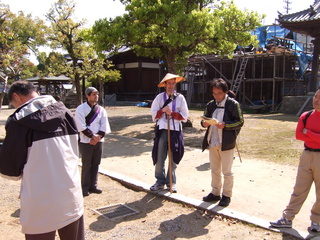 隠れた山寺へ
隠れた山寺へ
Journey to the Hidden Mountain Temple
平成18年から20年まで三豊市の豊中中学校でALTとして勤め、毎日本山寺の前にある道を通って通勤したが、その2年間一度も境内には入らなかった。平成22年4月24日の外国人のための四国八十八ヶ所遍路体験で初めてこのお寺を訪ね、国宝である本堂のきれいな屋根と空に聳える五重塔を見ると「早く来ればよかったのに」と思った。
I worked as an Assistant Language Teacher (ALT) for the two years from August 2006 to August 2008 at Toyonaka Junior High School in Mitoyo City, Kagawa Prefecture. However, during that whole time, I never once set foot inside Motoyamaji despite the fact that I commuted to work everyday on the street that runs right in front of the temple. I finally took my first steps inside on April 24, 2010 during the 5th Shikoku 88 Temple Circuit Experience for Foreign Residents and Visitors, with a group of fifteen other "pilgrims." We took in the gracefully curved lines of the temple's Main Hall, which was built during the Kamakura Period (1185-1333) and is a designated National Treasure, and we peered up at the towering five-storied pagoda. The beauty of the temple made me think to myself, "Why didn't I come here sooner?"
のどけしや
五重塔を
仰ぎけり
Gazing up, up at
The temple's tall pagoda -
Awash in Spring's calm
本山寺を出発し、北へ向かった。三豊市に点在する数多くの貯水池やゆるやかに起伏する平野を通り、次第に急になる坂道を11キロ歩いて、剣五山の麓にやってきた。山道を登り、俳句茶屋や賽の河原、金剛挙菩薩などを見ながら弥谷寺にたどり着いた。不思議に感じたのは、その山の懐に隠れているお寺は下から見えないが境内から見下ろすと三豊市全体が見えるということであった。本当にきれいな景色であった。
Our group left Motoyamaji and set off to the north. We passed Mitoyo's plentiful reservoirs and its low, rolling plains as we hiked 11 km up a path that gradually became steeper. We then reached the base of Kengozan Mountain, where we began our ascent up the steep path. On the way we saw a rest stop called the Haiku Jaya, on the walls of which were hung hundreds upon hundreds of haiku poems, written by pilgrims passing on their way through. We saw a strange piles of rocks called the "Sai no Kawara," which are said to have been made by the spirits of deceased young children in a display of respect for their parents and ancestors. We also saw the awesomely tall statue of Kongoken Bosatsu, or the bodhisattva with clasped hands, bending down to greet us as we passed by before finally arriving at Iyadaniji. I found it enchanting that, even though the temple cannot be seen from below on the approach, when you look out from its inner sanctuary, you can see the whole of Mitoyo City lying before you. It was truly a beautiful view.
懐に
隠れる寺の
春うらら
Clear, shining spring day -
Secretly hidden temple
In the mountain folds
弥谷寺の大師堂になる「獅子の岩屋」という洞窟で住職にお寺の歴史や文化、例えば「弥谷寺参り」という風習などについて説明していただいた。その後、弥谷寺の本堂と磨崖仏を見てから、険しい遍路みちくだりに挑戦した。路の一部が崩れ、一部が小川になっていたので降りるのが危なく感じられたが、木の枝を貫く木漏れ日はとても美しかった。海岸寺駅までの最後の6キロをゆっくりと歩き、穏やかな夕暮れの下で第5回の遍路体験はおしまいになった。
At Iyadaniji, the Daishi Hall (the hall dedicated to Kōbōdaishi Kūkai, the Buddhist monk who is credited with founding the Shikoku Pilgrimage) is built into a mountain cave called the Shishi no Iwaya - the Lion's Mouth Cave. Here the chief priest gave us an explanation of the history of the temple, as well as an introduction to some of the special customs of Iyadaniji, such as the "Iyadani Mairi," in which people bring the hair and finger nails of the deceased members of their family as offerings. After this, we hiked a little higher up to see the Main Hall and the images of the Buddha carved into the mountain wall before attempting the perilous downhill descent of the Pilgrimage Trail. Here, the path completely crumbled away at certain points and it merged with a mountain stream at others. Though it felt dangerous at times, we couldn't help but be mesmerized by the beauty of the sunlight filtering through the mountain's green trees. We made a leisurely walk of the last 6 km to Kaiganji Station, and beneath the sunset of a gentle evening sky, the 5th Henro Experience came to a close.
山裾の
林を抜ける
遍路かな
Exiting the woods
At the skirt of the mountain -
Pilgrims clad in white
クリス・マッケーブ
Chris McCabe
